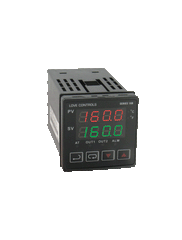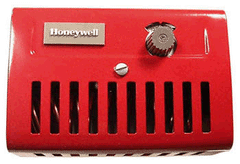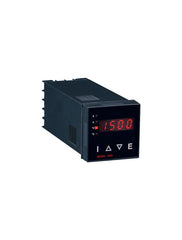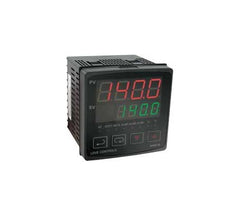TEMPERATURE CONTROLLERS FOR SALE










Temperature controllers are the brains behind maintaining ideal temperatures in a variety of applications. They act as gatekeepers, continuously monitoring and adjusting temperatures to ensure processes run smoothly and products are manufactured with consistency. These devices work by sensing the current temperature using sensors like thermocouples or RTDs and comparing it to a pre-set desired temperature. If the temperature deviates from the setpoint, the controller sends signals to an actuator (like a heater, cooler, or valve) to adjust the heating or cooling process back to the desired level.
These unassuming devices are found working diligently in countless industries. They are crucial in industrial manufacturing, regulating temperatures in ovens, furnaces, and reactors for metalworking, chemical, and pharmaceutical production. Temperature controllers are also indispensable in HVAC systems for keeping homes, offices, and other buildings comfortable. Their presence is vital in food processing, ensuring safe and consistent quality in refrigerators, ovens, and other food-related equipment. In the medical field, they maintain precise temperatures in incubators, blood analyzers, and other sensitive medical devices. Lastly, they are also used for environmental control, regulating temperatures in greenhouses, data centers, and other environments.
COMPONENTS OF A TEMPERATURE CONTROLLER
These devices rely on a coordinated effort of several key components to achieve precise and reliable temperature control.
Let's take a closer look at the essential parts that make up a typical temperature controller:
-
Sensor: Detects the actual temperature and sends a signal to the controller.
-
Controller: Processes the sensor signal, compares it to the setpoint, and generates an output signal.
-
Actuator: Receives the output signal from the controller and adjusts the heating or cooling system to achieve the desired temperature. This often involves relays, which are electrical switches that control the flow of power to the heating or cooling elements.
-
Display: Provides visual feedback on the current temperature, setpoint, and other parameters.
-
Input/Output: Allows for communication with other systems, such as programmable logic controllers (PLCs) or data logging systems.
MAIN TEMPERATURE CONTROLLER TYPES YOU CAN BUY AT BLACKHAWK SUPPLY
Looking for the perfect temperature controller to keep your processes running smoothly? Blackhawk Supply has you covered! We offer a diverse range of over 70 temperature controllers designed to meet your specific needs, from simple household applications to complex industrial requirements.
Dive into this section to explore the main types of temperature controllers we carry and find the ideal fit for your project.
Temperature Controllers By Mechanism
Temperature controllers can be broadly classified based on the underlying mechanism used to sense and control temperature.
-
Mechanical Temperature Controllers: These rely on physical properties like the expansion of a bimetallic strip or a liquid-filled bulb to sense temperature changes and actuate a switch. Mechanical controllers are often simple, reliable, and cost-effective, but their accuracy and control capabilities are limited.
-
Bulb temperature controllers, commonly found in household appliances, use a sealed bulb filled with a liquid that expands with temperature, triggering a switch.
-
Other examples of mechanical temperature controllers include thermostatic controls, which use a thermostat, often a bimetallic strip or a liquid-filled bulb, to sense temperature changes and activate heating or cooling systems. These controls are commonly found in HVAC systems for homes and buildings, where they regulate the temperature based on the desired setting on the thermostat.
-
-
Electronic Temperature Controllers: Electronic controllers use circuits and sensors to monitor and control temperature with greater precision and flexibility. They encompass a variety of types, including analog controllers, digital controllers, PID controllers, and microprocessor-based controllers. While more complex and expensive than mechanical controllers, they offer high accuracy, advanced features like alarms and data logging, and enhanced versatility.
Temperature Controllers By Functionality
The number of input signals used by a temperature controller determines its functionality and suitability for specific applications.
-
Single-Input Temperature Controllers: These controllers manage temperature based on a single input signal, typically from a temperature sensor. Examples include most bulb controllers and some electronic controllers. They are suitable for basic heating or cooling systems where only one temperature setpoint needs to be controlled.
-
Dual-Input Temperature Controllers: These controllers use two input signals to manage both heating and cooling systems simultaneously. Thermometer/heater/dual input controllers are a good example. Dual-input controllers are ideal for processes requiring precise control over both heating and cooling, such as temperature-sensitive environments.
Temperature Controllers By Control Complexity

The sophistication of the control algorithm employed by a temperature controller influences its ability to maintain accurate and stable temperatures.
-
On/Off Temperature Controllers: These controllers maintain the desired temperature by switching the heating or cooling system on or off. While simple and cost-effective, they often result in temperature fluctuations and cycling.
-
Proportional Temperature Controllers: Proportional controllers adjust the heating or cooling output based on the difference between the actual temperature and the setpoint. This provides smoother and more accurate temperature control compared to on/off controllers.
-
PID Temperature Controllers: PID controllers utilize a sophisticated control algorithm incorporating proportional, integral, and derivative components for highly accurate and responsive temperature control. They can handle complex temperature control challenges with minimal fluctuations but require more advanced knowledge and configuration.
WHAT TEMP CONTROLLER BRANDS CAN I BUY AT BLACKHAWK SUPPLY?
Looking for a top-quality temperature controller from a brand you can trust? Look no further than Blackhawk Supply!
We carry a wide range of temperature controllers from industry leaders, ensuring you find the perfect solution for your specific needs.
Johnson Controls Temp Controllers
Johnson Controls is a global leader in building technologies and solutions, with a rich history of innovation in temperature control. Their controllers are known for their reliability, accuracy, and ease of use. They offer a wide range of options, from basic thermostats to advanced programmable controllers, making them a popular choice for residential, commercial heating, and industrial applications.
Dwyer Instruments Temp Controllers
Dwyer Instruments specializes in innovative instrumentation and control solutions, with a focus on air quality, HVAC, and industrial process monitoring. Their temperature controllers are known for their rugged construction, durability, and accuracy, making them ideal for demanding environments. Dwyer offers a variety of controller types, including analog, digital, and PID controllers, catering to a wide range of applications.
Honeywell Temp Controllers
Honeywell is a global technology leader with a strong presence in the building and industrial automation sectors. Their temperature controllers are renowned for their advanced features, precise control, and connectivity options. Honeywell offers a diverse range of controllers, from basic thermostats to sophisticated smart thermostats and industrial-grade controllers, making them a versatile choice for a variety of needs.
Rinnai Temp Controllers
Rinnai is a leading manufacturer of high-efficiency water heaters, boilers, and HVAC systems. Their temperature controllers are known for their reliability, durability, and energy efficiency, making them a popular choice for residential and commercial applications. Rinnai offers a range of controllers designed to work seamlessly with their heating and cooling systems, providing precise temperature control and optimizing energy savings.
SHOP TEMPERATURE CONTROLLERS AT BLACKHAWK SUPPLY TODAY!
Looking for a temperature controller that's as reliable as it is easy to use? Blackhawk Supply has the perfect solution for your home or business. We offer a wide selection of top-quality options, ensuring you find the ideal fit for your needs. Shop with us and experience the difference a reliable temperature controller can make.
Shop with confidence, knowing you can return your purchase within 60 days and enjoy free shipping on orders over $999. Visit Blackhawk Supply today and find the ideal solution to keep your environment comfortable and efficient!
Popular Products
View all →




















